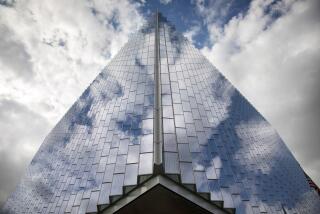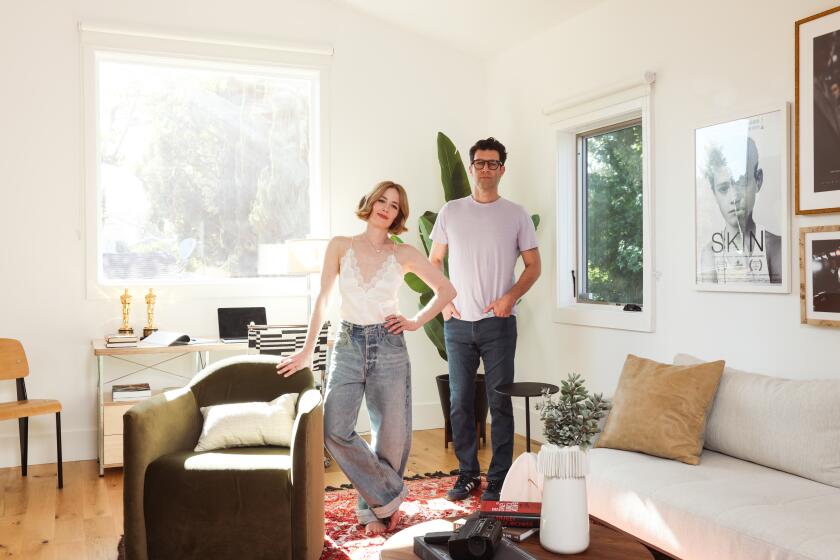Location a Magnet for Protesters
For more than three decades, Los Angeles protesters have flung their passionate objections against the hard, cold walls of a concrete-colored building in Westwood.
Thousands have yelled at it. Others have read insulting poetry to it. Angry women have disrobed before it. One motorist rammed it.
The Federal Building has weathered scores of protests staged on its grounds each year. The government wants to add an FBI headquarters on the property, but officials and employees say the protests simply will keep coming and maybe even increase.
“We’ve had every protest known to mankind,” said Mary Freeman, a Department of Veterans Affairs administrator who has worked at the office since it opened in 1969. “But after a while, it’s just more of the same. You kind of block it out.”
Demonstrations are so common that the building’s property managers have created a list of rules for those seeking protest permits.
Groups with more than 100 protesters, for example, must bring portable toilets and pay a $100 deposit to cover possible damage to the grounds (refundable when they leave and only if they take the toilets with them).
Also, no permits are granted for rallies expecting more than 1,500 participants.
Rules of the government, however, often mean little to those railing against it. Some protests draw thousands.
But the land where the federal building stands was not always inhabited by unruly dissidents.
According to the Westwood Historical Society, ranchers gave it to the government in the 1880s, hoping to bribe their way into getting a naval port built in Santa Monica Bay.
It was the first -- but far from the last -- time someone on the grounds tried to influence the government and failed.
In the 1960s, the federal government wanted to build a huge, multi-agency office on the 28-acre grounds, so they called in Charles Luckman, a prominent soap salesman turned architect.
“It was a beautiful building of classic design and proportions,” Luckman wrote in his 1988 autobiography.
The critics were not so kind.
“An immense file cabinet,” said one guide to Los Angeles architecture.
An architecture critic writing for The Times was even more harsh: “It looks like a cheap version of a commercial office building that sits all by itself because nobody wants to be near it.”
But to employees at the time, the building’s dull, white face was a shining beacon of air-conditioned hope compared with their old government digs.
“It was exciting to leave the ‘huts,’ ” said Reuben Wein, 90, referring to the dark and gloomy, Quonset huts that housed Veterans Affairs employees in the 1960s. “At least the new building didn’t have pigeons flying around the rafters.”
The new building did, however, attract another kind of annoyance.
The list of protests since the building opened reads like a history textbook, from the buildup of nuclear arms to the Iran-Contra affair to the Rodney King verdict.
The fringe and strange have come as well. Artists have shown up with pictures of a gagged Mona Lisa and a neutered statue of David. Sweaty dancers, spurred on by local DJs, have gotten down on the lawn to protest a federal law that cracked down on rave parties where drugs are sold.
And Hollywood celebrities, of course, have preached -- and posed -- for fashionable causes.
Protesters with some publicity know-how usually bring props.
“We’ve had fake bombs, coffins, big papier-mache heads of [President] Bush and a pair of boots representing every soldier who’s died in Iraq,” said Jim McDonald, deputy property manager of the immense, block-like building.
Why are protesters so crazy about the Westwood building? After all, there are at least 10 other federal buildings in Los Angeles County.
For one, employees say, the property has “government” written all over it. More than 1,000 federal employees work there for the FBI, Veterans Affairs and the State Department’s passport agency.
Fourteen flagpoles flying Old Glory are squeezed United Nations-style into one corner of the lot.
And if that fails to inform, a billboard-sized sign screams with white, foot-long letters: “Federal Building 11000 Wilshire.”
“It’s that sign. They just see that word ‘federal,’ and they come running,” said Veterans Affairs worker Dawn Russell Edwards, waving her hands as if the imagined protesters were pesky mosquitoes.
McDonald attributed his building’s popularity to its convenient location near the San Diego Freeway.
“Of course, the proximity to UCLA students with plenty of time on their hands doesn’t hurt either,” he said.
Though the list of protests favors the left in general, demonstrations often are bipartisan, equal opportunity and internationally inclusive. Yes, U.S. flags have been burned, but so have Soviet and Chinese flags.
“Honk if you’re against the war,” read some signs.
“Honk if you support our troops,” read others.
Edwards, the VA worker, wants a sign of her own: “Honk if you can’t get out of the parking lot because protesters are tying up the streets.”
“It’s already backed up on a normal day,” she said. “When they’re out there, it takes me an hour to get from the parking lot to Wilshire Boulevard ... and the parking lot is [practically] on Wilshire.”
Though most crowds are peaceful, things have gotten ugly.
“The worst was when we had anti- and pro-immigration groups at the same time,” said McDonald, former regional chief of the Federal Protective Service, which guards the building.
“At first, we had them separated by the boulevard. But when traffic died down, some ran across the street. They were throwing soda cans, swinging signs.”
In 1987, one man even drove his car up the steps of the building and slammed into the lobby. No one was injured. That same year, another man burned himself to death on the lawn to protest the Iranian government of Ayatollah Ruhollah Khomeini.
“It can get crazy,” Edwards said.
And it’s likely to get crazier.
“Oh, they’ll be coming,” said property manager McDonald, thinking of the summer ahead.
“A war always stirs things up. And besides, it’s an election year.”
More to Read
Sign up for Essential California
The most important California stories and recommendations in your inbox every morning.
You may occasionally receive promotional content from the Los Angeles Times.










